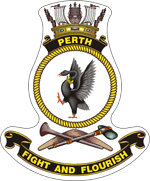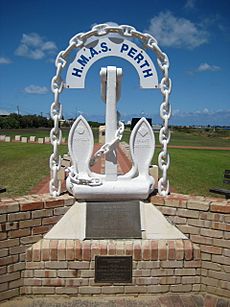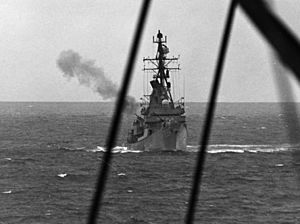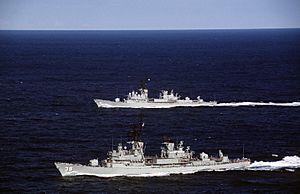HMAS Perth (D 38) facts for kids

HMAS Perth underway during the early 1990s
|
|
Quick facts for kids History |
|
|---|---|
| Namesake | City of Perth |
| Builder | Defoe Shipbuilding Company, Michigan, US |
| Laid down | 21 September 1962 |
| Launched | 26 September 1963 |
| Completed | 22 May 1965 |
| Commissioned | 17 July 1965 |
| Decommissioned | 15 October 1999 |
| Motto | "Fight And Flourish" |
| Honours and awards |
|
| Fate | Sunk as dive wreck 24 November 2001 |
| Badge |  |
| General characteristics | |
| Class and type | Perth-class (Modified Charles F. Adams-class) destroyer |
| Displacement |
|
| Length |
|
| Beam | 14 m (46 ft) |
| Draught | 6 m (20 ft) |
| Propulsion | 4 × Foster Wheeler boilers, 2 × General Electric steam turbines, 70,000 shp (52 MW), 2 propellers |
| Speed | 35 knots (65 km/h; 40 mph) |
| Range | 6,000 nautical miles (11,000 km; 6,900 mi) at 15 knots (28 km/h; 17 mph) |
| Complement | 311 sailors, 22 officers |
| Armament |
|
HMAS Perth (D 38) was a special type of warship called a guided missile destroyer. It was the first ship in its class, the Perth-class, used by the Royal Australian Navy (RAN). This ship was built in the United States, based on a design from the US Navy. Perth started serving in the RAN in 1965.
The destroyer went to the Vietnam War three times. For its service, it earned a special RAN award called a battle honour and two awards from the United States Navy. For most of its time in service, Perth took part in training exercises and visited other countries as a friendly gesture. It even traveled as far as the Mediterranean Sea. Perth was taken out of service in 1999. In 2001, it was purposely sunk off the coast of Western Australia to become a dive wreck for people to explore underwater.
Contents
Building a Destroyer: Design and Construction
Perth was the first of three Perth-class guided missile destroyers built for the RAN. These ships were based on the United States Navy's Charles F. Adams design. Perth was a large ship, weighing 3,370 tons when empty and 4,618 tons when fully loaded. It was about 134 meters (440 feet) long and 14 meters (46 feet) wide. The ship could go as fast as 35 knots (about 65 kilometers per hour or 40 miles per hour). A crew of 22 officers and 311 sailors operated the ship.
What Weapons Did HMAS Perth Carry?
As a guided missile destroyer, Perth had powerful weapons. Its main weapon was a Mark 13 missile launcher that fired Tartar missiles. Later, it was updated to fire Standard missiles. The ship also had two large 5"/54 caliber Mark 42 guns and two sets of triple torpedo tubes. Over time, the ship was updated. It received Ikara anti-submarine missile launchers in 1966–67, which were later removed in 1991. Two Phalanx CIWS units, which are fast-firing guns for defense, were also added.
Where Was HMAS Perth Built?
Perth was built at the Defoe Shipbuilding Company in Bay City, Michigan, USA. Its construction began on September 21, 1962. The ship was launched into the water on September 26, 1963, by the wife of the Australian Ambassador to the United States. Building Perth cost $45 million. It was officially ready for service with the RAN on July 17, 1965. Before sailing to Australia, Perth spent eight months in American waters for tests and training. It then sailed to its home city, Perth, Australia, in February 1966.
HMAS Perth's Time at Sea: Operational History
Perth spent most of its career on various missions and exercises. In April 1967, it was sent to Macquarie Island to rescue a sick researcher. The weather was so bad that a diver from the ship had to swim ashore with a liferaft to bring the person back.
HMAS Perth in the Vietnam War
In the mid-1960s, Australia decided to send warships to help the United States in the Vietnam War. Australian destroyers like Perth played several important roles:
- Coastal Patrols: They patrolled the coast of North Vietnam to stop enemy ships from moving supplies. They also attacked supply lines and military targets on land.
- Gunfire Support: They used their powerful guns to help ground troops, especially the United States Marine Corps, by firing at enemy positions. When doing this, Perth used the callsign "Gunpowder."
- Stopping Infiltration: They helped stop supplies and reinforcements from reaching enemy forces in South Vietnam by checking coastal ships.
- Escorting Aircraft Carriers: They protected US Navy aircraft carriers that were launching airstrikes.
Australian ships were under the command of the United States Seventh Fleet during these deployments. Australia was the only allied country to provide naval support to the US Navy during the Vietnam War.
First Vietnam Deployment (1967–1968)
Perth began its first tour in Vietnam on September 14, 1967. It was first assigned to provide gunfire support for the US Army's 1st Cavalry Division. Later, it moved north to respond to increased enemy activity. On October 18, 1967, Perth was hit by coastal artillery fire. The shell bounced off the back gun turret and caused a fire inside the ship. No one was seriously hurt, and the crew quickly put out the fire. The gun turret captain received a medal for his brave actions. Six days later, Perth and another US ship sank five enemy supply boats.
Perth continued its missions, often facing challenges like gun malfunctions. Despite these issues, the crew worked hard to keep the ship operational. On February 2, 1968, Perth had to go for repairs due to problems with a gun turret and a propeller. After repairs, its commanding officer was even put in charge of both the northern and southern patrol units. Perth finished its first tour on March 23, 1968. For its service, the ship received the United States Navy Unit Commendation. Many crew members also received awards for their bravery and skill.
Second Vietnam Deployment (1968–1969)
Perth returned to Vietnam on September 29, 1968. It quickly joined the gunline operations. On October 9, it took over as the leader of the northern patrol unit because another US ship had gun problems. The next day, the battleship USS New Jersey joined the unit, and Perth moved back to the southern force. On October 21, Perth saw 14 North Vietnamese prisoners of war being returned.
Later, a problem with its forward gun turret forced Perth to move to less demanding duties. The ship continued to provide gunfire support for various ground forces. It also had a brief trip to Taiwan in early 1969. Perth finished its second deployment on March 16, 1969. For this tour, the ship was awarded the United States Navy Meritorious Unit Commendation. Several crew members received individual awards for their excellent service.
Third Vietnam Deployment (1970–1971)
Perth began its third and final tour in Vietnam on September 26, 1970. It started by providing gunfire support. On October 23, the ship supported a mission by US Navy SEALs, a special forces team. On November 14, both of its main gun turrets became unusable, though one was fixed later that day. Perth continued to move between different operational areas, providing support where needed.
In January 1971, Perth spent five days protecting the aircraft carrier USS Hancock. It then returned to gunfire support duties. The forward gun turret broke down again in late January. After repairs, Perth operated in other regions, but there wasn't much activity. The ship left the gunline for the last time on March 7, 1971. It was then part of an escort group for the carrier USS Ranger. Perth completed its Vietnam deployment on March 29, 1971.
In 1971, the Australian government decided to pull all its forces out of Vietnam. Perth received the battle honour "Vietnam 1967–71" for its three deployments.
HMAS Perth in the 1970s and 1980s
In February 1973, Perth went on a friendly visit to ports in Africa with two other Australian ships. In July 1974, it sailed to California, USA, for a major upgrade and refit. After returning to Sydney in September 1975, Perth spent most of the next two years on training exercises. In 1980, the ship's engines were changed to run on diesel fuel instead of furnace oil. This upgrade finished in May.
In September 1980, Perth joined five other RAN ships to form the Australia Squadron. This group, led by the flagship Melbourne, spent two months in the Indian Ocean. This was the largest RAN deployment since World War II. In 1981, Perth went on another long deployment to the Indian Ocean. It visited many ports and participated in Exercise Kangaroo 81, a large military exercise.
From April 1983 to July 1984, Perth was in dry dock for another refit. In 1985, it took part in Exercise Flying Fish. Later that year, it deployed to South-east Asia. In February 1986, while visiting Hobart, Tasmania, Perth accidentally hit a wharf with its bow. It damaged the wharf and a building, but the ship itself was not too badly damaged and could still take part in Exercise Tasman Sea. After this, Perth made many port visits around Australia and in South-east Asia. It spent most of 1989 in dock for maintenance and upgrades.
HMAS Perth in the 1990s
In February 1990, after its upgrades, Perth sailed to Hobart to be the main ship for the Royal Hobart Regatta. It then went to South-east Asia in May, taking part in naval exercises and visiting ports. In mid-1991, Perth sailed to the Mediterranean Sea, traveling through South-east Asia and eastern Africa. It returned to Sydney in August and spent the rest of the year on training and visiting New Zealand.
In early 1990 (this seems to be a typo and should be 1992), Perth returned to South-east Asia, then operated off Western Australia, and later in the South China Sea. The ship spent early 1994 visiting ports in Western Australia, New Guinea, and New Zealand before going into refit in June. This refit finished in March 1995. Later that year, the ship sailed to the South China Sea for multinational naval exercises. In 1996, Perth participated in RIMPAC, a large international naval exercise. It returned to Hawaii for another RIMPAC exercise in 1998. In 1999, its last year, Perth mainly focused on exercises and a final deployment to South East Asia, including its first visit to Vietnam since the war. It also completed a trip around Australia before being taken out of service.
Decommissioning and Fate

Perth was officially taken out of service on October 15, 1999. In December 1999, the ship was given to the Western Australian government. It was then purposely sunk as a dive wreck off the coast of Albany, Western Australia, on November 24, 2001. This created an artificial reef and a cool place for divers to explore.
The original ship's bells from Perth and an older warship also named Perth (from World War II) are on display at the Perth Town Hall.
Freedoms
HMAS Perth was given the special honour of the Freedom of the City in these locations:
 March 4, 1966: Perth.
March 4, 1966: Perth.




